Insulation Ursa: advantages and disadvantages of materials
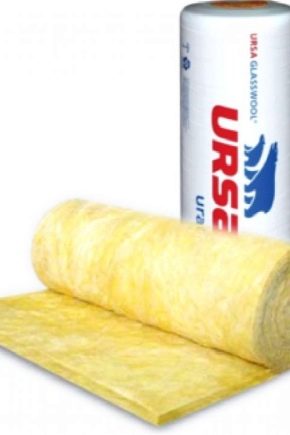
In the 21st century, manufacturers of building materials still cannot fully guarantee high thermal insulation. Very often, in order to achieve more or less acceptable performance in thermal insulation, it is necessary to increase the thickness of the floors in the building. As a consequence, the entire structure becomes enormous, and therefore much more stringent requirements are applied to the frame, foundation and soil.
The use of Ursa insulation fully helps designers and builders not to face many difficulties and problems. The material significantly reduces heat loss, keeps a comfortable microclimate in the premises well. At the same time, the insulation is lightweight, which significantly reduces the consumption of building materials during construction, in the subsequent operation of the building helps to reduce energy consumption for heating premises, and also increases the soundproofing of walls and ceilings.
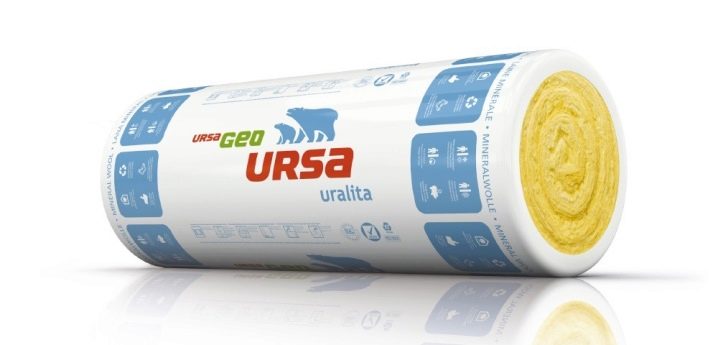
What it is?
Let's consider what are its advantages and main differences.
- Heat insulator Ursa was specially designed for home use, at the same time, this material fully meets all the requirements of professional construction. Plates of this insulation have increased rigidity and small size (at the same time, elasticity and flexibility are fully preserved at the proper level), this convenience allows you to install the insulation on your own without any problems.
- The indicators of thermal conductivity, moisture resistance and sound insulation of this insulation are maximum in their values. One of the main features of Ursa Terra insulation is that during production it is treated with a unique water-repellent composition, therefore, if it gets on the surface of the insulation, water drops roll off it, completely not penetrating into the material.
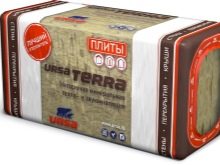


- Heat insulator Ursa - non-combustible material, it is perfect for insulating wooden buildings. And due to the use in the production of only ecological natural components, this insulation is absolutely harmless to humans and the environment, it is able to maintain the microclimate of houses built of wood.
The Ursa product range includes slabs and technical mats for duct and pipe insulation.


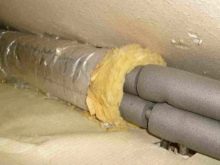
Peculiarities
Distinctive quality characteristics of Ursa insulation are at the same time its advantages.
- Thermal conductivity. For this heat insulator, it is calculated in the range of 0.031-0.049 W / Mk, it perfectly keeps the required temperature in any building, and does not at all reduce the characteristics of thermal insulation at high humidity, even with direct contact with moisture.
- Strength. Insulation plates can hold loads up to 175 kPa, as well as short-term pressure up to 500 kPa, during the entire operation (this is a period of more than 50 years). The excellent flexural strength allows building elements to be mounted even on unprepared substrates, such as a sand cushion.



- Temperature range of application. It is recommended to use this insulation at temperatures from -55 to +80 degrees. At the same time, the products are very resistant to freezing, five hundred freezing / thawing processes are permissible.This insulation is recommended for use in buildings with fairly frequent temperature changes.
- Security. The Ursa heat insulator is absolutely harmless to humans, because no harmful elements are used at all during its production. Moreover, fire retardants have been added to the composition, and, as a result, the insulation belongs to completely non-combustible materials, that is, when the flame is close, a gas barrier is created that prevents the access of oxygen, as a result of which the flame stops burning.
It is also important that thermal insulation is successfully used in structures that are located next to the ground or vegetation, and at the same time fully retains all its useful properties.



The basis of the Ursa heat insulator is a specially treated fiberglass. In its production, an equal amount of dolomite, sand and soda was used. There are other useful additives in the composition.
When, in the process of heating all the constituent ingredients, the mixture begins to melt, it is passed through a special apparatus, as a result, after processing, the basis for the Ursa insulation is obtained, which has a fiber structure, all the threads of which are glued together. Heat insulator Ursa is a truly original material, as it has a large number of advantages over other types of insulation.
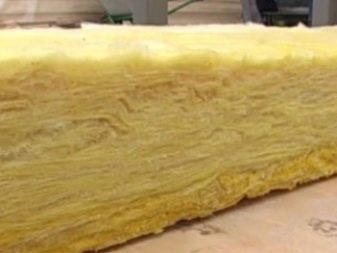
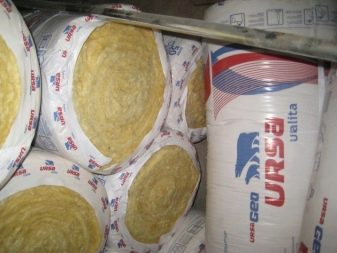
In Russia, there are several branches of the Ursa company, which is the manufacturer of this insulation, it is based on very strong glass fiber and mineral wool. With Ursa, you can insulate any place in the structure of the house. The sound insulation and resistance to mechanical stress of the Ursa insulation are at the highest level.
Excellent thermal insulation, compliance with all environmental standards, very good thermal protection, the service life of this insulation is more than 50 years. Insulation Ursa is resistant to temperature extremes, versatile, non-flammable, elastic and flexible, easy to install, affordable, has a low weight.
Insulation Ursa is very vapor-permeable, bio-resistant, not subject to decomposition and mold.
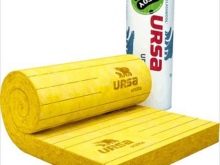

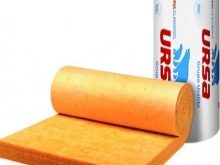
There are also some disadvantages, for example, to work with it, you must wear protective glasses and gloves.
The material is susceptible to alkali. The cost of Ursa insulation depends on a specific type and area of application, as well as on the density of the product. One set of insulation costs 390-1490 rubles.
The heat insulator is tested and named the most environmentally friendly. When preparing raw materials, all components of the insulation are carefully checked, and the finished Ursa products are absolutely harmless to human health and nature.

Note that any fiberglass material manufactured by Ursa may emit some dust. It is recommended that all walls in the house be covered with a waterproofing membrane. Since this insulation is based on quartz sand, the material is non-combustible, which is very good for insulation in a wooden house. Note the great durability of Ursa heaters. Even after 40-50 years of operation, the characteristics of the material will remain the same.
Another important feature of this insulation is biological stability. All substances used in the production of this insulation are inorganic and do not attract insects and rodents. Fungus and mold will also not harm this material.


Types and characteristics
There are several types of Ursa heat insulator, each has its own advantages and disadvantages, different types differ in their characteristics.

Ursa geo
This heat insulator is able to preserve the heat of your home as much as possible. This is achieved by the length and elasticity of its fibers, between which there are several layers of air. Even mineral wool usually does not give such a good effect as this heat insulator. Therefore, you do not have to worry that with the arrival of winter, the walls of the house will freeze. This type of insulation has a minimum of thermal conductivity. The sound insulation class of this insulation is A, this is confirmed by certificates and proven by many laboratory tests.Almost all varieties of Ursa are good at absorbing sounds.
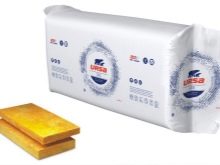

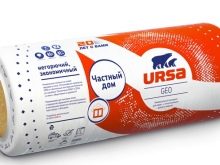
Ursa PureOne
This heat insulator is designed with advanced technology. For example, the main binder component of this insulation is acrylic, a neutral polymer that does not pose any danger to human health. Thanks to the use of this component, the fiberglass is dust-free and non-prickly. This means that this type of insulation can definitely be used to insulate nurseries, kindergartens and medical institutions.
In terms of sound absorption, this material is even better than stone wool. It is more flexible; over time, its shape remains the same.
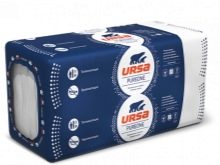


Ursa XPS
This heat insulator has increased strength and is resistant to deformation. The material perfectly withstands both significant stretching and strong bends or compression. In the production of this type of insulation, carbon dioxide is used, and it does not belong to toxic substances. Therefore, the Ursa XPS heat insulator is completely harmless to human health and the environment.
Remember that toxic substances can start to be produced when the temperature is too high. This material does not absorb moisture, so its thermal insulation characteristics remain the same even when exposed to groundwater. In the process of freezing and subsequent thawing, the properties of the product also remain the same, which significantly distinguishes it from any other heaters.
This variety, like other Ursa products, is considered durable and non-combustible. XPS has also been used successfully for foundation protection in buildings and road construction.
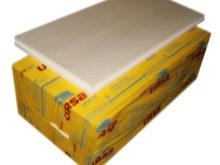


Ursa terra
Ursa Terra is more suitable than other types for insulating a residential building. The peculiarity of Ursa Terra slabs is their increased rigidity and compact dimensions. This insulation is best suited for wooden buildings, since it is completely non-flammable. Ursa Terra is additionally coated with special moisture-repelling compounds. Moreover, it has improved sound insulation and thermal conductivity.
In the production of this insulation, exclusively natural ingredients are used, as a result, the insulation becomes completely harmless to humans and the environment.


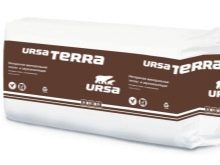
Product lines
The company offers a wide range of insulation materials. Let's talk about the entire line of thermal insulators from the manufacturer Ursa.
- Ursa M 11 - fiberglass heat insulator. Soft, lightweight and resilient. Very pleased with the price. But there are also disadvantages: it is not very flexible and cannot boast of special strength. And when installing Ursa M 11, you must use a respirator and gloves to avoid getting small particles of fiberglass on your skin.
- Ursa M 11 F - on one side it is covered with aluminum foil for vapor barrier, which prevents moisture from penetrating inside the insulation and prevents condensation from forming. Such insulation is very effective for use in houses with high humidity and in contact with water, for example, a bathhouse or basement.


- Ursa M 15 - very elastic, has a good compression ratio. It is mainly used for insulating pitched roofs, floors, various partitions.
- Ursa M 25 - produced in the form of a roll with excellent thermal insulation and flexibility. But this type of insulation is used only indoors, outdoors, in the ground or in pipes, it is unsuitable. Heat insulator Ursa M 25 has proven itself well for insulating pipelines with a diameter of 33 cm. Ursa M 25 absorbs the sound of industrial boilers and tanks. Recommended for insulation of pitched, attic and mansard roofs.


- Ursa P 15 - used in the insulation of frame walls and partitions, as well as pitched roofs. Installation of this insulation can be carried out by one person. Ursa P 15 is very light, but at the same time very resilient.
- Ursa P 20 - used for insulation of external walls. Ursa P 20 is mounted either in the middle layer of the wall or outside. This insulation has very good thermal and sound insulation.
- Ursa P 30 - very elastic and flexible, thanks to these qualities, this insulation is perfectly mounted on the surface. It has proven itself well when used in rectangular gas and air ducts.

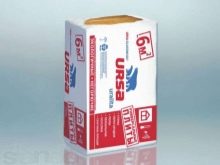

- Ursa P 35 - vapor-tight and resistant to various vibrations. Basically, this insulation is used in railway, water and road transport in order to retain heat and suppress noise.
- Ursa P 60 - fits well under flooring (tiles, laminate and similar coatings). This insulation has maximum sound-absorbing properties.
- Ursa Light - very lightweight, resilient, durable, non-combustible material. And it does not respond to changes in ambient temperature and chemical attack.



- Ursa pitched roof - produced in the form of yellow mats, this insulation has excellent sound and heat insulation, good elasticity. Another plus of this insulation: during installation, practically no waste is generated.
- Ursa Facade - papered over with very strong black fiberglass. Perfectly insulates systems with ventilated gaps. It has heat and sound insulation, keeps its shape remarkably.
- Ursa Partition - well suited for installation on framed partitions. The properties of this insulation are: lightness, elasticity, noise absorption and thermal insulation.



Which to choose?
Heat insulators Ursa do not burn, do not rot, do not emit harmful substances. If the insulation weighs insignificantly, then it is perfect for insulating a room from the inside. Heavier insulation is usually installed on facades.
It should be noted that all Ursa heat insulators use two types of materials, which, due to the optimal combination of advantages and disadvantages, are recognized as the best heat insulators. These are fiberglass and extruded polystyrene foam. Mineral wool and glass wool are a thing of the past.
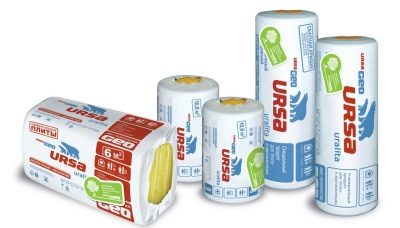
Subtleties of use
The features of the installation of the Ursa heat insulator are simple and quick.
Even one person who is not a professional in construction can install Ursa tile or roll insulation, and the installation of the insulation is very simple due to rolls and plates that are small in size and the necessary elasticity. The main thing in laying insulation is a well-prepared surface., since the Ursa insulation is mounted precisely on the base (boards or plywood). The material is laid quite tightly to the surface itself, fixed with self-tapping screws.
If you correctly calculate the required amount of insulation, then at the end of the work there will be no residues and surpluses.

Installation of thermal insulation Ursa
You do not need any special knowledge and skills to install such Ursa heaters. You just need to follow a few rules. Proper transportation and proper storage of the material, protection from atmospheric moisture and physical damage are important. It is recommended to lay the insulation not too tightly, since the performance characteristics can be lost at high density.
If you plan to store the insulation for a long time, it is recommended not to remove the original packaging until the insulation is applied. But immediately before installation, the insulation must be held unfolded for at least ten minutes. Before starting work, always wear special goggles, clothing and gloves that are as closed as possible so that dust does not fall on exposed skin. Use a small saw or a well-sharpened knife to cut the material.

Try to lay the heat insulator plates as tightly as possible, and then lightly press them against the base.
If you plan to place insulation in two layers, then you must definitely overlap the joints.
For the installation of the Ursa heat insulator, it is best to use compounds based on cement or polyurethane.

The main advantages of using Ursa heaters
The heat insulator Ursa, as the leader in the insulation market, has parameters, thanks to which it enjoys very high ratings among consumers.
Thermal conductivity
The main task of any heat insulator is to create good thermal insulation, Ursa heaters cope with this task at the highest level, it is always cool in the premises during a hot summer, and in winter the owners of the house feel comfortable warmth. An important characteristic of the insulation is its incombustibility, which makes it safe and significantly expands the scope of use.

Physical properties
The flexibility and elasticity of the materials allows the Ursa thermal insulator to adhere to surfaces of any size and shape as much as possible, with absolutely no gaps. The ductility of the insulation boards allows them to be transported without risking damaging it during transportation or during its shipment.

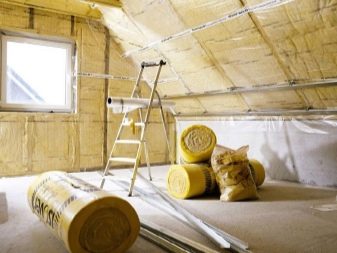
Ecology
During installation and during operation, Ursa insulation does not emit any volatile chemicals at all; this insulation can definitely be classified as one of the cleanest materials that do not violate the environment. This is achieved by the manufacturer through the introduction of the most modern technologies. Insulation Ursa can be used in childcare facilities and in hospitals.
Environmentally friendly - a heater is created using natural gas, and, unlike freon, it is completely safe for the ozone layer of the atmosphere of our planet.


Roof insulation
If during the installation of the thermal insulator you follow all the rules of the technology, then you will save up to 50% of your heating bills on heating your house.

Hydrophobicity
Ursa heaters are not subject to condensation, which causes fungal organisms to form. And they are also not afraid of groundwater, they do not absorb moisture at all,

Fire safety and sound insulation
The basis of Ursa insulation is fiberglass, and it does not burn at all. In the event of a fire, fiberglass will prevent the flames from harming the building and will significantly mitigate possible damage from fire. If you put the insulation plates on the partitions between the rooms, then all unwanted noises will not bother you and your comfort will not be disturbed.
Note that laying the insulation will not impede air circulation.

Installation and operation
- The big advantage when working with Ursa is that there is no waste when installing this insulation, and the entire procedure can be performed independently, without outside help, all this due to the low weight of the insulation material and its good flexibility. Insects are indifferent to Ursa insulation and rodents are indifferent, and harmful microorganisms do not survive on its surface and inside.
- The insulation keeps both direct sunlight and mechanical stress remarkably. The material is very strong - the slabs can withstand a load of 50 tons per sq. meter. Insulation Ursa is frost-resistant and resistant to moisture - it retains its properties even when in water. This insulation can be used in structures where the temperature often changes. Insulation is a very strong material, it can withstand more than 500 heating / freezing cycles. The service life of the insulation after installation is 50 years.

- Insulation Ursa is effective and requires minimal labor during installation. The light weight of the material and its elasticity reduce the time spent on installation work. To install the insulation, no special devices and skills are required at all.
- Heat insulator Ursa is made of fiber, safe for human health., even when ingested, the fibers of the material are excreted naturally, without causing any harm to the body. At the same time, the fibers do not dissolve and are not damaged in ordinary water. Foil heat insulator is the best choice for home insulation. Confirmed by a certificate. The indisputable advantages that are inherent in the Ursa heat insulator will allow you to enjoy dryness and warmth in your home for many years.


Correct insulation and roof insulation using Ursa heat insulator
Note that it is best for you to perform competent insulation of the roof from the inside during construction. And it is always better to insulate a concrete slab from the outside, laying a layer of heat insulator under a soft roof, it is more convenient and efficient, better than hemming from the inside.
The scheme of such insulation is as follows:
- First, we put a waterproofing membrane on the concrete, then Ursa insulation on top of it.
- Then, on top, we arrange a cement-sand screed with a minimum thickness of 30 mm.
- Completion of roof insulation - laying of roofing material - roofing felt.

The composition of the roof insulation kit depends on the material. But two rules are always the same for all insulation options:
- a diffusion membrane must be installed under the roof covering. It does not allow moisture to pass through, but allows steam to escape;
- there must be ventilation between any covering and the membrane through which air circulates.
Important: if there is no diffusion membrane on the old roof, then for insulation it is necessary to remove the coating (slate or metal tile) and lay the waterproofing outside.
Heat transfer always goes from hotter air to colder air. In winter, warmth in the premises tends to go outside, and in summer, heat tends to inside the house. To make the house comfortable and cozy in terms of temperature, it is required to lower the thermal conductivity of the structures that make up the building.
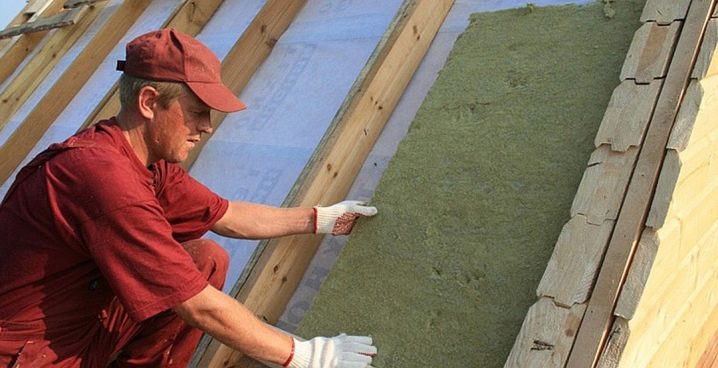
The ability of materials to conduct heat is characterized by the coefficient of thermal conductivity. The lower its value, the better the thermal protection of the material. It is thermal conductivity that is the main selection criterion, according to which heaters are selected.
The properties of the entire structure are evaluated using the coefficient of resistance to heat transfer. The higher the value of this coefficient, the higher the energy efficiency of the building. The normative values of this coefficient apply, they are calculated according to special building codes of practice, which take into account the climate and type of building.

Sizes and shapes
In order for the walls of the building to meet the requirements of the standards, you will need to build:
- or a brick wall with a thickness of seven rows of bricks (176 cm);
- or a concrete wall 5 meters thick;
- or a wall insulated with 8 centimeters of Ursa heat insulator.

Reviews
Having conducted a study of reviews on forums, websites and social networks about the use of Ursa insulation, we can say with confidence that 99.6 percent of reviews about this insulation are positive.
Of the shortcomings, they note the complexity of working with the material and the need to use protective equipment during the installation of this heat insulator. The second (and last) disadvantage of the Ursa thermal insulator is its poor moisture resistance. When water gets inside the heat insulator, it partially loses its properties. Therefore, it is advisable not to wet the insulation; condensate should not accumulate inside the already built structures.
Use plastic wrap, kraft paper, or aluminum foil as insulators.


You will see how to properly insulate a frame house using URSA TERRA in the next video.













The comment was sent successfully.